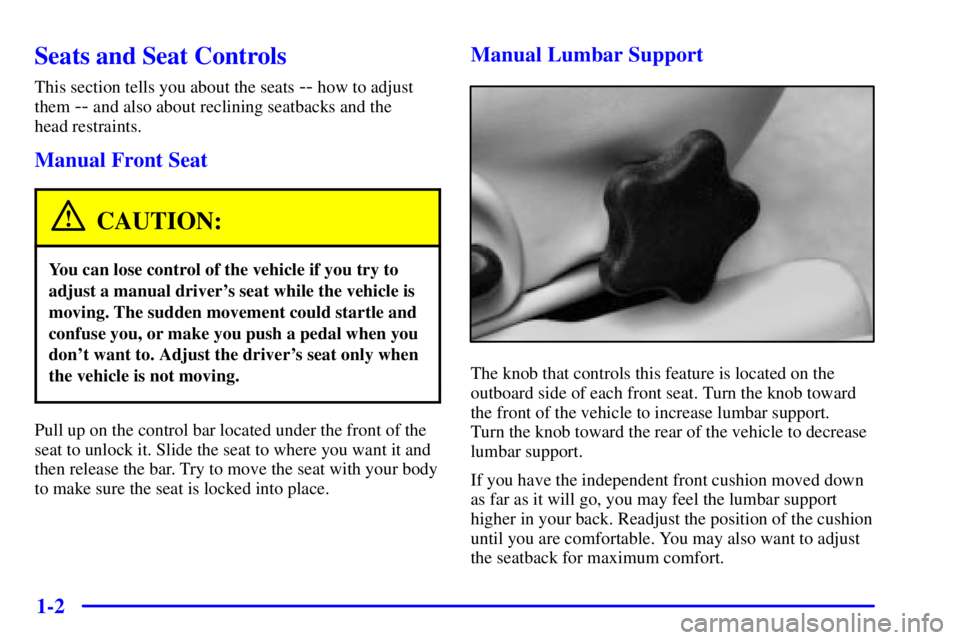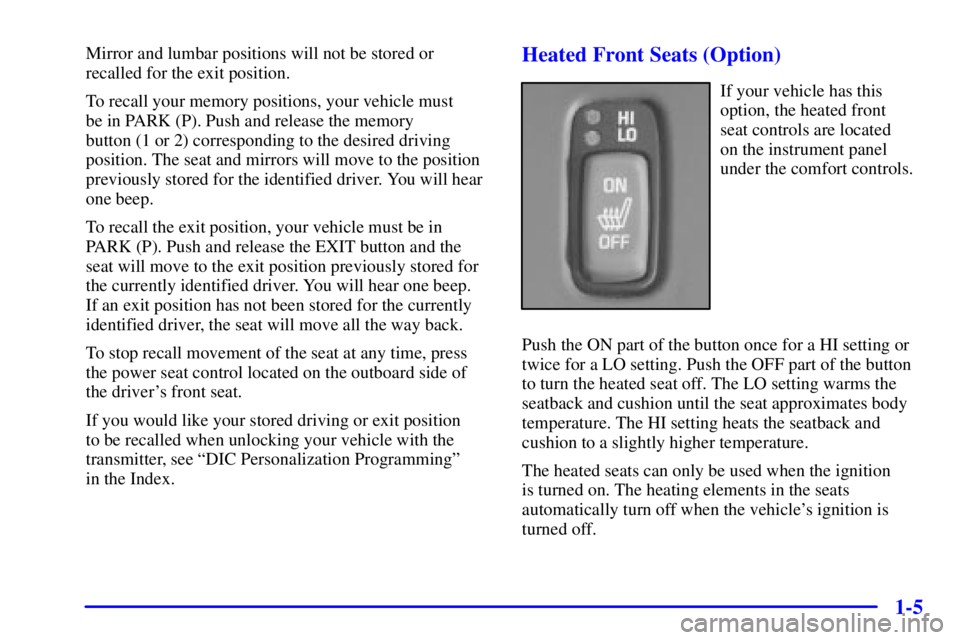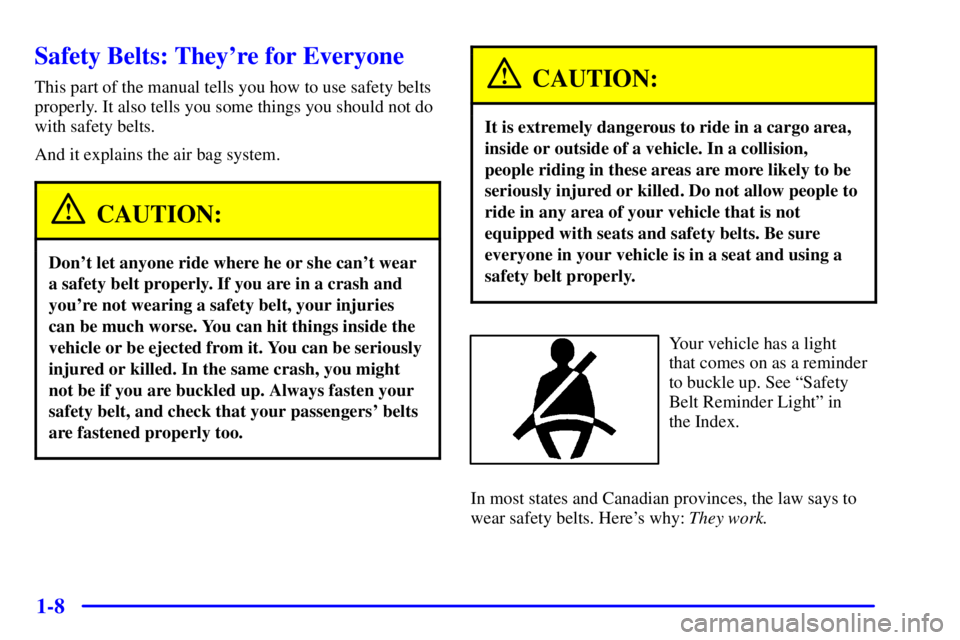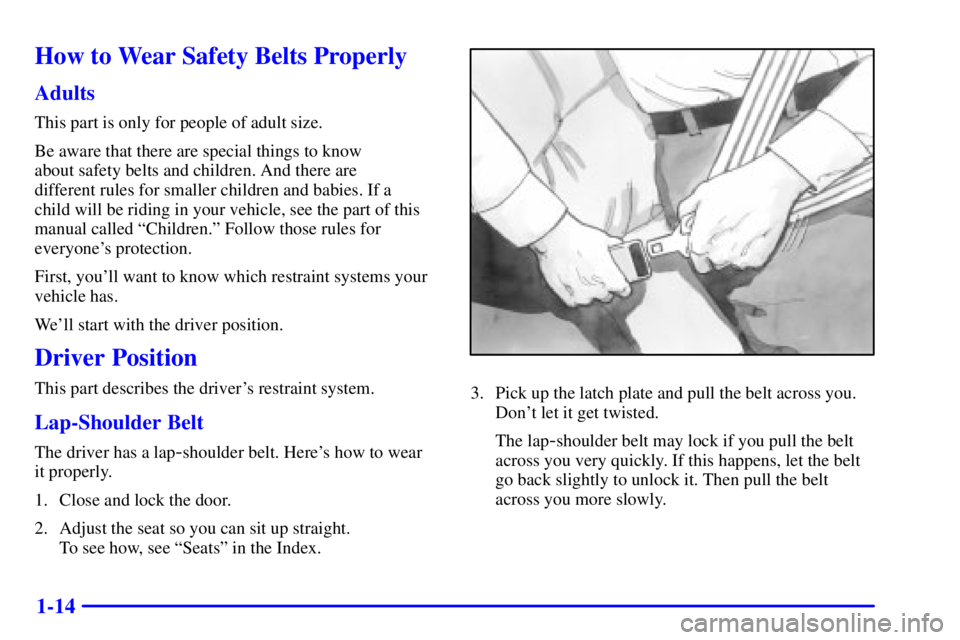Page 7 of 427
1-
1-1
Section 1 Seats and Restraint Systems
Here you'll find information about the seats in your vehicle and how to use your safety belts properly. You can also
learn about some things you should not do with air bags and safety belts.
1
-2 Seats and Seat Controls
1
-8 Safety Belts: They're for Everyone
1
-12 Here Are Questions Many People Ask About
Safety Belts
-- and the Answers
1
-14 How to Wear Safety Belts Properly
1
-14 Driver Position
1
-20 Safety Belt Use During Pregnancy
1
-21 Right Front Passenger Position
1
-21 Air Bag Systems
1
-30 Center Front Passenger Position1
-32 Rear Seat Passengers
1
-35 Rear Safety Belt Comfort Guides for Children
and Small Adults
1
-37 Children
1
-41 Restraint Systems for Children
1
-55 Older Children
1
-58 Safety Belt Extender
1
-58 Checking Your Restraint Systems
1
-58 Replacing Restraint System Parts
After a Crash
Page 8 of 427

1-2
Seats and Seat Controls
This section tells you about the seats -- how to adjust
them
-- and also about reclining seatbacks and the
head restraints.
Manual Front Seat
CAUTION:
You can lose control of the vehicle if you try to
adjust a manual driver's seat while the vehicle is
moving. The sudden movement could startle and
confuse you, or make you push a pedal when you
don't want to. Adjust the driver's seat only when
the vehicle is not moving.
Pull up on the control bar located under the front of the
seat to unlock it. Slide the seat to where you want it and
then release the bar. Try to move the seat with your body
to make sure the seat is locked into place.
Manual Lumbar Support
The knob that controls this feature is located on the
outboard side of each front seat. Turn the knob toward
the front of the vehicle to increase lumbar support.
Turn the knob toward the rear of the vehicle to decrease
lumbar support.
If you have the independent front cushion moved down
as far as it will go, you may feel the lumbar support
higher in your back. Readjust the position of the cushion
until you are comfortable. You may also want to adjust
the seatback for maximum comfort.
Page 9 of 427
1-3 Power Seats (If Equipped)
If your vehicle has this feature, the controls for the
power seats are located on the outboard side of each
front seat.To adjust the power seats, do the following:
Horizontal Control: Raise or lower the front of the seat
cushion by pressing the forward edge of the control up
or down.
Raise or lower the rear of the seat cushion by pressing
the rear edge of the control up or down.
Move the seat forward or rearward by pressing the
control towards the front or rear of the vehicle.
Move the seat higher or lower by holding the whole
control up or down.
Vertical Control (Option): Move the seatback into
a recline position by pressing the top of the control
backward. Move the seatback forward by pressing the
top of the control forward.
Page 11 of 427

1-5
Mirror and lumbar positions will not be stored or
recalled for the exit position.
To recall your memory positions, your vehicle must
be in PARK (P). Push and release the memory
button (1 or 2) corresponding to the desired driving
position. The seat and mirrors will move to the position
previously stored for the identified driver. You will hear
one beep.
To recall the exit position, your vehicle must be in
PARK (P). Push and release the EXIT button and the
seat will move to the exit position previously stored for
the currently identified driver. You will hear one beep.
If an exit position has not been stored for the currently
identified driver, the seat will move all the way back.
To stop recall movement of the seat at any time, press
the power seat control located on the outboard side of
the driver's front seat.
If you would like your stored driving or exit position
to be recalled when unlocking your vehicle with the
transmitter, see ªDIC Personalization Programmingº
in the Index.Heated Front Seats (Option)
If your vehicle has this
option, the heated front
seat controls are located
on the instrument panel
under the comfort controls.
Push the ON part of the button once for a HI setting or
twice for a LO setting. Push the OFF part of the button
to turn the heated seat off. The LO setting warms the
seatback and cushion until the seat approximates body
temperature. The HI setting heats the seatback and
cushion to a slightly higher temperature.
The heated seats can only be used when the ignition
is turned on. The heating elements in the seats
automatically turn off when the vehicle's ignition is
turned off.
Page 14 of 427

1-8
Safety Belts: They're for Everyone
This part of the manual tells you how to use safety belts
properly. It also tells you some things you should not do
with safety belts.
And it explains the air bag system.
CAUTION:
Don't let anyone ride where he or she can't wear
a safety belt properly. If you are in a crash and
you're not wearing a safety belt, your injuries
can be much worse. You can hit things inside the
vehicle or be ejected from it. You can be seriously
injured or killed. In the same crash, you might
not be if you are buckled up. Always fasten your
safety belt, and check that your passengers' belts
are fastened properly too.
CAUTION:
It is extremely dangerous to ride in a cargo area,
inside or outside of a vehicle. In a collision,
people riding in these areas are more likely to be
seriously injured or killed. Do not allow people to
ride in any area of your vehicle that is not
equipped with seats and safety belts. Be sure
everyone in your vehicle is in a seat and using a
safety belt properly.
Your vehicle has a light
that comes on as a reminder
to buckle up. See ªSafety
Belt Reminder Lightº in
the Index.
In most states and Canadian provinces, the law says to
wear safety belts. Here's why: They work.
Page 20 of 427

1-14
How to Wear Safety Belts Properly
Adults
This part is only for people of adult size.
Be aware that there are special things to know
about safety belts and children. And there are
different rules for smaller children and babies. If a
child will be riding in your vehicle, see the part of this
manual called ªChildren.º Follow those rules for
everyone's protection.
First, you'll want to know which restraint systems your
vehicle has.
We'll start with the driver position.
Driver Position
This part describes the driver's restraint system.
Lap-Shoulder Belt
The driver has a lap-shoulder belt. Here's how to wear
it properly.
1. Close and lock the door.
2. Adjust the seat so you can sit up straight.
To see how, see ªSeatsº in the Index.
3. Pick up the latch plate and pull the belt across you.
Don't let it get twisted.
The lap
-shoulder belt may lock if you pull the belt
across you very quickly. If this happens, let the belt
go back slightly to unlock it. Then pull the belt
across you more slowly.
Page 41 of 427
1-35
Rear Safety Belt Comfort Guides for
Children and Small Adults
Rear shoulder belt comfort guides will provide added
safety belt comfort for older children who have
outgrown booster seats and for small adults. When
installed on a shoulder belt, the comfort guide better
positions the belt away from the neck and head.
There is one guide for each outside passenger position
in the rear seat. To provide added safety belt comfort
for children who have outgrown child restraints and for
smaller adults, the comfort guides may be installed on
the shoulder belts.Here's how to install a comfort guide and use the
safety belt:
1. Remove the guide from its storage pocket on the side
of the seatback.
Page 48 of 427
1-42
A forward-facing child seat (C-E) provides restraint for
the child's body with the harness and also sometimes
with surfaces such as T
-shaped or shelf-like shields.
A booster seat (F-G) is a child restraint designed to
improve the fit of the vehicle's safety belt system. Some
booster seats have a shoulder belt positioner, and some
high
-back booster seats have a five-point harness. A
booster seat can also help a child to see out the window.